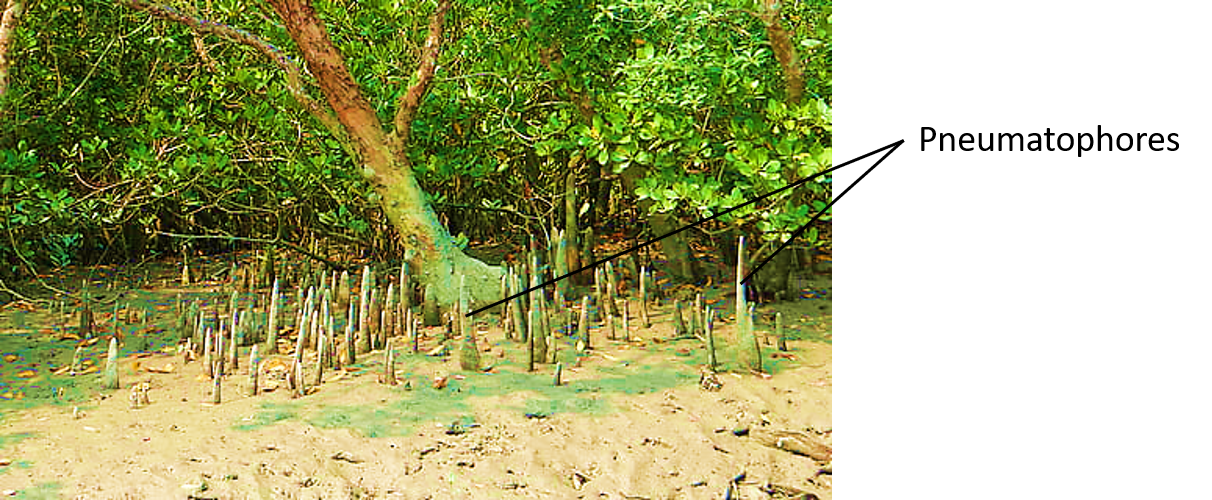
Pneumatophores occurs in plants of
(a) Sandy soil
(b) Saline marshy soil
(c) Marshy soil
(d) Water
Answer
482.1k+ views
Hint: An aerial root system that is specialized for the gaseous exchange in plants. Found mainly in coastal area plants like mangroves arranged in the opposite direction of the usually occurring roots.
Complete answer:
Mangroves grow in the salt marshy soil producing pneumatophore, which is a type of root which grows negatively geotropic for taking in oxygen from the air. They are pencil-like roots that stick up out of the dense, wet ground like snorkels.
Respiratory roots - these roots are found in the plants which grow in marshy areas and are aquatic. In aquatic plants floating roots act as respiratory roots. In marshy areas, the roots are unable to get sufficient oxygen to respire and hence it grows upwards
Mangrove pneumatophores vary in size and morphological characteristics. The black mangroves (Avicennia spp.) have pencil-like or fingerlike pneumatophores, while those of Sonneratia species are conical. Pneumatophores are usually seen as unbranched, but branching can occur when they get damaged. A pneumatophore height is generally measured to have less than 30 cm for Avicennia, less than 20 cm for Laguncularia, and from 30 to 3 m for Sonneratia species, size varies according to the species. Pneumatophore density is typically measured large; as for an example, a 2–3 m-tall Avicennia marina tree usually contains about 10,000 pneumatophores.

So the correct answer is, ‘‘saline marshy soil.’’
Note: Pneumatophores are a type of respiratory root which helps for the respiration for the plants which grow in aqueous and marshy lands and so the roots are grown towards making it negatively geotropic. These aerial roots are beneficial for the coastal plants and control flood and other calamities to an extent.
Complete answer:
Mangroves grow in the salt marshy soil producing pneumatophore, which is a type of root which grows negatively geotropic for taking in oxygen from the air. They are pencil-like roots that stick up out of the dense, wet ground like snorkels.
Respiratory roots - these roots are found in the plants which grow in marshy areas and are aquatic. In aquatic plants floating roots act as respiratory roots. In marshy areas, the roots are unable to get sufficient oxygen to respire and hence it grows upwards
Mangrove pneumatophores vary in size and morphological characteristics. The black mangroves (Avicennia spp.) have pencil-like or fingerlike pneumatophores, while those of Sonneratia species are conical. Pneumatophores are usually seen as unbranched, but branching can occur when they get damaged. A pneumatophore height is generally measured to have less than 30 cm for Avicennia, less than 20 cm for Laguncularia, and from 30 to 3 m for Sonneratia species, size varies according to the species. Pneumatophore density is typically measured large; as for an example, a 2–3 m-tall Avicennia marina tree usually contains about 10,000 pneumatophores.

So the correct answer is, ‘‘saline marshy soil.’’
Note: Pneumatophores are a type of respiratory root which helps for the respiration for the plants which grow in aqueous and marshy lands and so the roots are grown towards making it negatively geotropic. These aerial roots are beneficial for the coastal plants and control flood and other calamities to an extent.
Recently Updated Pages
Master Class 11 Accountancy: Engaging Questions & Answers for Success

Express the following as a fraction and simplify a class 7 maths CBSE

The length and width of a rectangle are in ratio of class 7 maths CBSE

The ratio of the income to the expenditure of a family class 7 maths CBSE

How do you write 025 million in scientific notatio class 7 maths CBSE

How do you convert 295 meters per second to kilometers class 7 maths CBSE

Trending doubts
10 examples of friction in our daily life

One Metric ton is equal to kg A 10000 B 1000 C 100 class 11 physics CBSE

Difference Between Prokaryotic Cells and Eukaryotic Cells

State and prove Bernoullis theorem class 11 physics CBSE

What organs are located on the left side of your body class 11 biology CBSE

Write down 5 differences between Ntype and Ptype s class 11 physics CBSE




